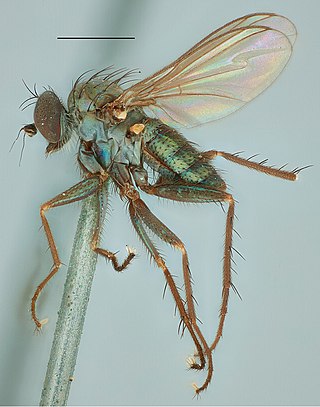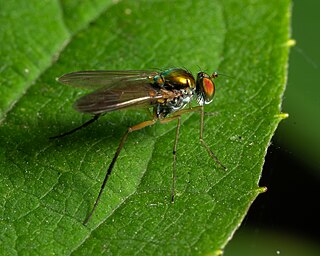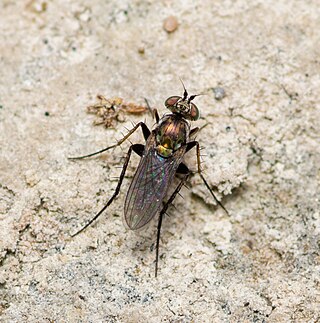
Argyra is a genus of flies in the family Dolichopodidae. The name "Argyra" comes from the Greek word for "silver", referring to the silver pruinescence found on the males of many of the species.

Achradocera is a genus of flies in the family Dolichopodidae. It is distributed in the Nearctic and Neotropical realms as well as in Polynesia. Several Afrotropical species were also placed in the genus, but in 2018 they were transferred to Chrysotus. Achradocera was formerly considered a subgenus of Chrysotus, but was restored as a separate genus by Harold E. Robinson (1975).

Asyndetus is a genus of flies in the family Dolichopodidae. There are more than 100 species described for the genus, distributed worldwide.

Diaphorus is a genus of flies in the family Dolichopodidae. Lyroneurus was formerly considered a subgenus, but is now either treated as a synonym of Chrysotus or treated as a distinct genus.

Medetera is a large genus of flies in the family Dolichopodidae. It includes about 350 species worldwide. The adults are commonly found resting on vertical surfaces such as tree trunks, on which they have a characteristic vertical upright stance. Because of this stance, they are sometimes known as "woodpecker flies". Medetera adults are predators of soft-bodied arthropods, while the larvae are predators of bark beetle larvae.

Nematoproctus is a genus of flies in the family Dolichopodidae. It has an uncertain position in the family; different authors have included the genus in the subfamily Diaphorinae or the subfamily Rhaphiinae.

Paraclius is a genus of flies in the family Dolichopodidae. It is currently considered a polyphyletic assemblage of species.

Rhaphium is a genus of flies in the family Dolichopodidae. It is the largest genus within the subfamily Rhaphiinae, with over 200 species currently known.
Saccopheronta is a genus of flies in the family Dolichopodidae. It is considered a synonym of Medetera by some authors, and a valid genus by others.

Sympycnus is a genus of flies in the family Dolichopodidae.

Syntormon is a genus of flies in the family Dolichopodidae. It includes about 110 species worldwide, more than 50 of which were described from the Palaearctic realm.

Tachytrechus is a genus of long-legged flies in the family Dolichopodidae.

Dolichopodinae is a subfamily of flies in the family Dolichopodidae.

Gymnopternus is a genus of flies in the family Dolichopodidae. It was formerly placed as a subgenus of Hercostomus, but is now accepted as a separate genus.

Sympycninae is a subfamily of flies in the family Dolichopodidae. In some classifications, this subfamily includes the genera of the subfamilies Peloropeodinae and Xanthochlorinae.
Lyroneurus is a genus of flies in the family Dolichopodidae. It includes 17 species distributed in the Neotropical realm. It was formerly treated as a subgenus of Diaphorus; more recently Lyroneurus has been treated as a synonym of Chrysotus, but Capellari & Amorim (2010) maintains it as a distinct genus noting that Chrysotus is possibly paraphyletic.














